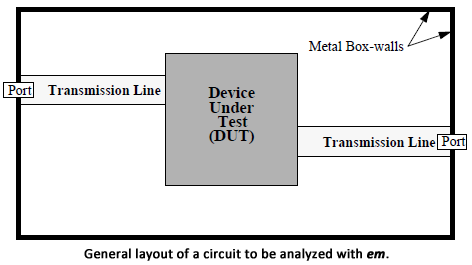De-embedding is the process of calibrating the ports, similar to a calibration of an RF measurement system with the probes or connectors used in the measurement. Sonnet de-embedding is performed automatically, behind the scenes, and in most cases, is not a concern for the user. However, just as in an RF measurement, understanding of the inner workings of the process can sometimes allow you to design your circuits in such a way as to produce more accurate results or analyze your circuit more efficiently.
Each port in a circuit analyzed by em introduces a discontinuity into the analysis results. In addition, any feed transmission lines that might be present introduce phase shift, and possibly, impedance mismatch and loss. Depending upon the nature of your analysis, this may or may not be desirable. De-embedding is the process by which the port discontinuity and feed transmission lines are removed from the analysis results.
The figure below illustrates the general layout of a circuit to be analyzed with em. The device under test (DUT), shown as a box in the figure, is the circuitry for which we wish to obtain analysis results. The DUT is located inside the metal box and is connected to one or more ports. The ports may be located on box-walls, as in the figure, or in the interior of the metal box (see Ports for a description of port types available in em). Typically, feedlines are necessary to connect the ports to the DUT.
When de-embedding is enabled, em performs the following sequence of steps:

Upon completion of the de-embedding process, em outputs de-embedded S-parameter results.
The de-embedding algorithm uses a Short Open Calibration (SOC) technique. For an in-depth discussion of the calibration technique, please see reference [4] and for a discussion of the de-embedding technique used for co-calibrated ports see reference [6] in Sonnet References.